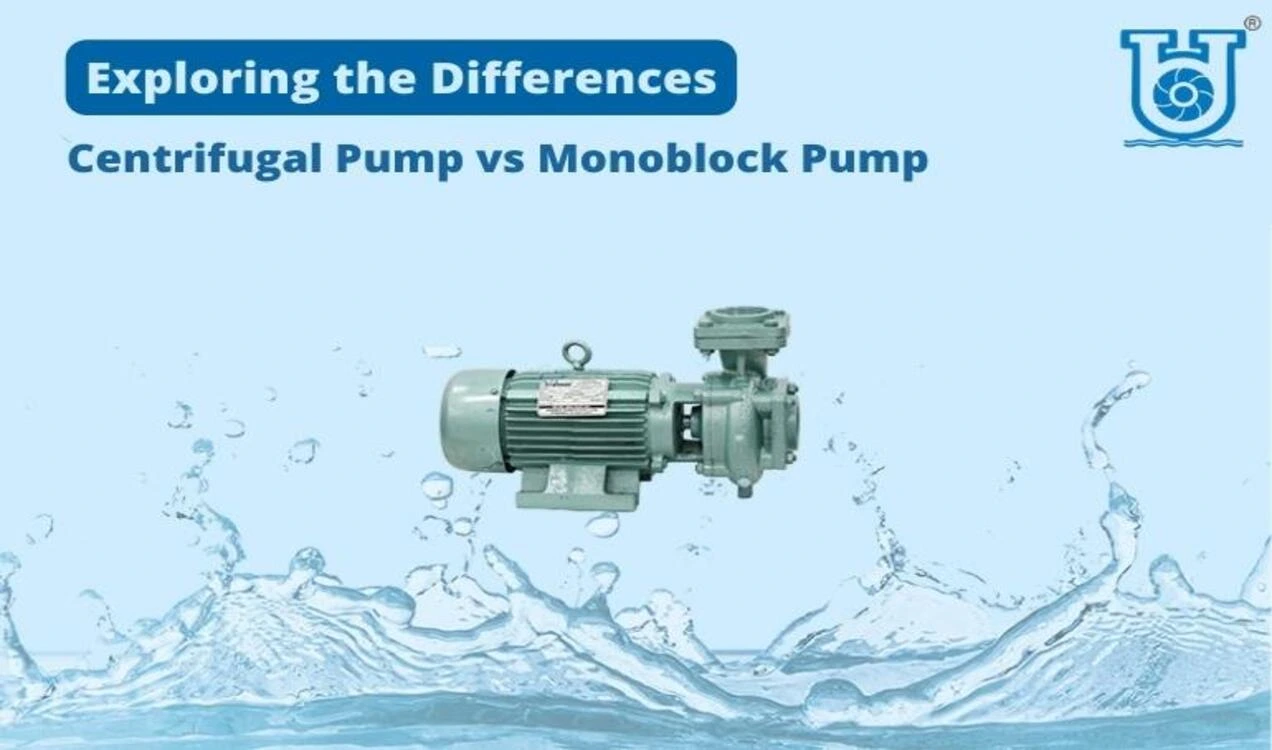When it comes to pumping fluids, there are two generally utilised options: centrifugal pumps and monoblock pumps. Both kinds fulfill the objective of transporting liquids; however, they vary in design, functioning, and application. In this blog article, we will cover the distinctions between centrifugal pumps and monoblock pumps, giving you a full grasp of each kind and their unique benefits.
Understanding Centrifugal Pumps:
The essential principle underpinning centrifugal pumps is that they move fluids by transforming rotational energy into kinetic energy. They do this by deploying a fast-rotating impeller that provides a centrifugal force that drives the fluid outward.
The fluid’s kinetic energy develops as it moves through the pump, allowing it to be released at a bigger pressure and flow rate. Numerous industries, including agriculture for irrigation, manufacturing for fluid transfer, wastewater management, HVAC systems, and oil and gas processing, employ centrifugal pumps extensively.
Understanding Monoblock Pumps:
Monoblock pumps are a sort of pump that boasts an integrated design where the motor and pump are combined into a single unit. This small shape avoids the need for separate motor and pump assembly. The motor and pump are placed in a single casing, resulting in a space-saving design.
One of the fundamental benefits of monoblock pumps is their ease of installation and maintenance. Due to its integrated design, installation is easy, and there are fewer components to assemble. Maintenance chores like cleaning and lubrication are substantially simplified, making them more user-friendly.
Design and Construction:
A. Centrifugal Pumps:
- Impeller and Casing: The impeller is a critical component in centrifugal pumps since it is responsible for fluid flow. It comprises curved blades that revolve fast, providing centrifugal force that pushes the fluid outward. The casing, on the other hand, guides the flow of fluid and contains the impeller. It is built with specifically formed channels that guarantee the fluid is routed properly.
- Shaft and Motor: The shaft serves a critical function in connecting the impeller to the motor. It transmits the rotational energy from the motor to the impeller, permitting fluid flow. Due to the high rotating speeds involved, the shaft must have a sturdy construction to resist the forces applied during operation.
B. Monoblock Pumps:
- Integrated Design: The motor and pump are housed in the same casing as monoblock pumps, which offers an integrated design. The necessity for separate motor and pump components is eliminated by this integrated construction, resulting in a small and space-saving design.
- Motor Placement and Coupling: In monoblock pumps, the motor is directly linked to the pump without the necessity of a separate base plate or connection. The motor is incorporated into the pump casing, offering a more streamlined and economical design. This direct connection avoids vibration and alignment concerns that might develop with separate motor components. It also simplifies the installation procedure and boosts the overall stability of the pump.
Functionality and Performance:
A. Centrifugal Pumps:
- Operating Principle: Centrifugal pumps function by exploiting centrifugal force created by the revolving impeller. As the impeller rotates, the fluid is pushed outward from the center towards the casing walls. This centrifugal force provides pressure that permits the fluid to be evacuated from the pump. The pressure and flow rate created depend on elements such as the size and speed of the impeller.
- Performance Range and Efficiency: Centrifugal pumps are very effective at handling large volumes of fluids. They are flexible for a variety of tasks since they can take varying viscosities. They work well for moderate-pressure applications but are not the best choice for really high-pressure requirements.
B. Monoblock Pumps:
- Operational Features: Monoblock pumps work similarly to centrifugal pumps in that fluid flow is initiated by the impeller’s rotation. However, compared to bigger centrifugal pumps, their modest size often forces them to operate at lower flow rates and capacities. They are thus more suited for small-scale or household applications.
- Suitable Applications: Monoblock pumps find particular relevance in home settings, such as residential water supply, irrigation, and minor industrial activities. Their small size and ease of installation make them useful for circumstances where space is restricted or simplicity of design and operation are sought. While they may not be suited for high-demand applications, they excel in offering efficient fluid movement in smaller-scale circumstances.
Application Considerations:
When deciding between centrifugal pumps and monoblock pumps for a certain application, numerous considerations should be addressed. These include the needed flow rate, pressure requirements, fluid viscosity, space limits, and budget constraints. Evaluating these criteria will assist in establishing the most appropriate pump type for the best performance and cost-effectiveness.
Maintenance and Troubleshooting:
To guarantee maximum performance and lifetime, frequent maintenance is necessary for both centrifugal pumps and monoblock pumps. Perform regular inspections to discover any leaks, worn-out components, or anomalies. Clean the pumps periodically to eliminate dirt and avoid blockage. Lubricate moving components as advised by the manufacturer. For troubleshooting, address typical concerns, including poor flow, excessive noise, or overheating. Check for appropriate alignment, impeller damage, and worn-out seals. Promptly fix any concerns to avoid additional damage and guarantee dependable pump functioning.
Conclusion:
Centrifugal pumps and monoblock pumps are two unique kinds of pumps with distinctive designs, functionality, and applications. Understanding their peculiarities and analysing the unique requirements of your pumping demands will help you make an educated selection. Whether you require a pump for industrial operations or home water supplies, selecting the proper model will guarantee efficient fluid flow and dependable performance.
You can also read: Monoblock Pump vs. Self-Priming Pump: Which is Better?


